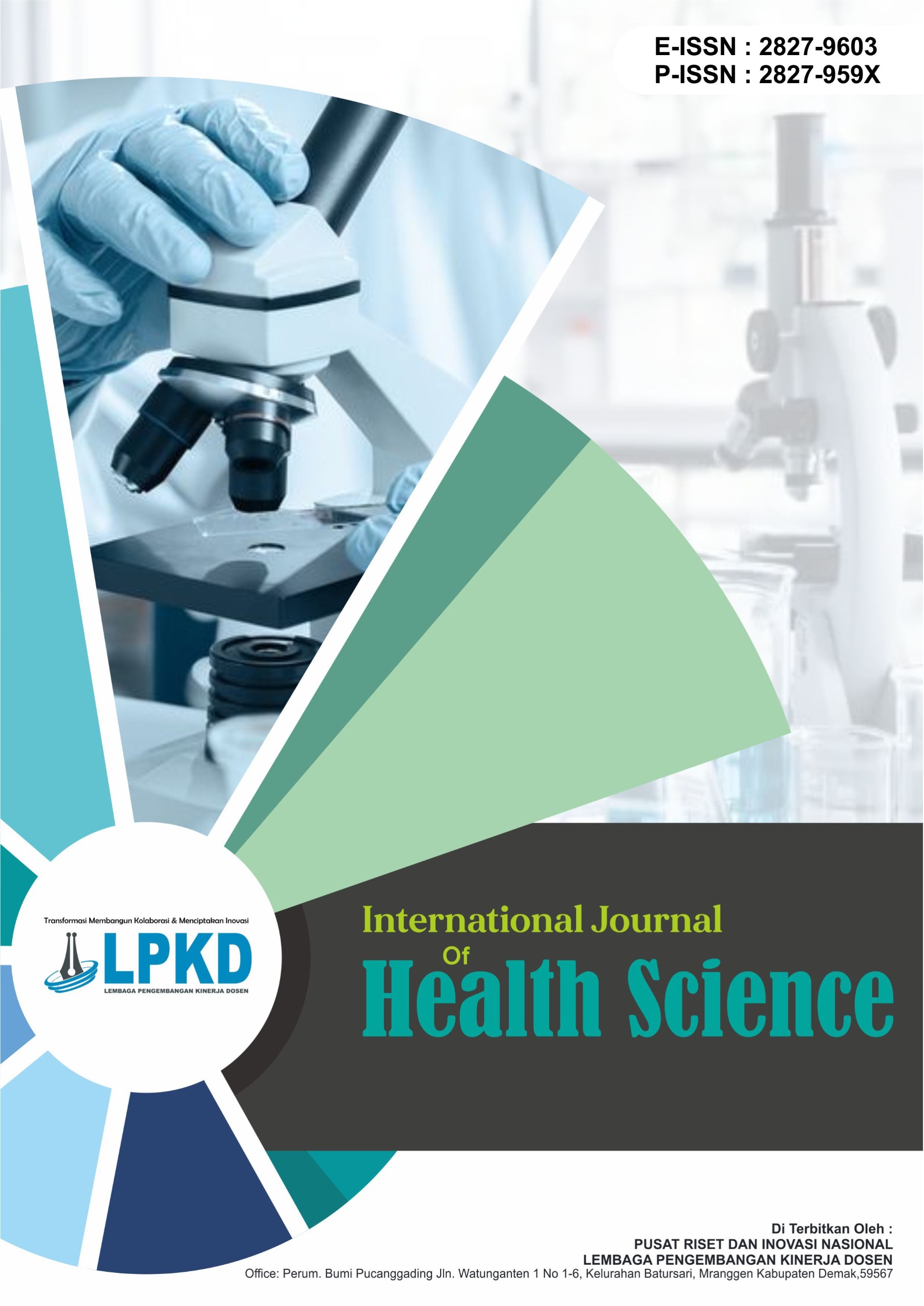Administrative Resilience in Middle Eastern Healthcare within Conflict Zones
DOI:
https://doi.org/10.55606/ijhs.v5i3.6206Keywords:
Administrative Resilience, Conflict Zones, Factor Analysis, Health Systems, Middle EastAbstract
This study examines the construct of administrative resilience within mental and physical health service systems in Middle East conflict zones using Confirmatory Factor Analysis (CFA) within Structural Equation Modeling (SEM). Data were derived from 847 policy documents and operational reports from twelve countries (2018–2024), accessed through official online sources. The measurement model showed good fit indices (χ²/df = 2.134, CFI = 0.962, TLI = 0.955, RMSEA = 0.047, SRMR = 0.038), indicating structural stability and validity of the theoretical model. CFA confirmed four dimensions of administrative resilience with significant loadings: Adaptive Policy (λ = 0.871, CR = 12.453, p < 0.001), Cross-Sector Coordination (λ = 0.834, CR = 11.287, p < 0.001), Professional Competence (λ = 0.792, CR = 10.564, p < 0.001), and Operational Stability (λ = 0.815, CR = 11.098, p < 0.001). Reliability results were strong (Cronbach's α = 0.863–0.921; Composite Reliability = 0.879–0.934; AVE = 0.647–0.782). Findings reinforce Boin and Lodge’s (2016) concept of organizational resilience and extend Comfort et al. (2010) by integrating operational stability as a relevant dimension in conflict settings. Unlike Kruk et al. (2015), which focused on general health systems, this study identifies unique adaptive mechanisms within dual mental–physical services while addressing the fragmentation gap noted by Jawad et al. (2019) through empirical formulation of interdependent administrative dimensions.
Downloads
References
Ager, A. K., Lembani, M., Mohammed, A., Mohammed Ashir, G., Abdulwahab, A., De Pinho, H., ... & Zarowsky, C. (2015). Health service resilience in Yobe state, Nigeria, in the context of the Boko Haram insurgency: A systems dynamics analysis using group model building. Conflict and Health, 9(1), 30. https://doi.org/10.1186/s13031-015-0056-3
Arbuckle, J. L. (2022). IBM SPSS Amos 26 user’s guide. IBM. https://www.ibm.com/docs/en/SSLVMB_26.0.0/pdf/amos/IBM_SPSS_Amos_User_Guide.pdf
Barasa, E. W., Cloete, K., & Gilson, L. (2017). From bouncing back to nurturing emergence: Reframing the concept of resilience in health systems strengthening. Health Policy and Planning, 32(suppl_3), iii91–iii94. https://doi.org/10.1093/heapol/czx118
Blanchet, K., Nam, S. L., Ramalingam, B., & Pozo-Martin, F. (2017). Governance and capacity to manage resilience of health systems: Towards a new conceptual framework. International Journal of Health Policy and Management, 6(8), 431–435. https://doi.org/10.15171/ijhpm.2017.36
Boin, A., & Lodge, M. (2016). Designing resilient institutions for transboundary crisis management: A time for public administration. Public Administration, 94(2), 289–298. https://doi.org/10.1111/padm.12264
Borenstein, M., Hedges, L. V., Higgins, J. P. T., & Rothstein, H. R. (2021). Introduction to meta-analysis (2nd ed.). Wiley. https://www.wiley.com/en-us/Introduction%2Bto%2BMeta%2BAnalysis%2C%2B2nd%2BEdition-p-9781119558354
Charlson, F., van Ommeren, M., Flaxman, A., Cornett, J., Whiteford, H., & Saxena, S. (2019). New WHO prevalence estimates of mental disorders in conflict settings: A systematic review and meta-analysis. The Lancet, 394(10194), 240–248. https://doi.org/10.1016/S0140-6736(19)30934-1
Cohen, J. (1960). A coefficient of agreement for nominal scales. Educational and Psychological Measurement, 20(1), 37–46. https://doi.org/10.1177/001316446002000104
Comfort, L. K., Boin, A., & Demchak, C. C. (Eds.). (2010). Designing resilience: Preparing for extreme events. University of Pittsburgh Press. https://doi.org/10.2307/j.ctt5hjq0c
Ekzayez, A., Al-Khalil, M., Jasiem, M., Al Saleh, R., Alzoubi, Z., Meagher, K., & Patel, P. (2020). COVID-19 response in northwest Syria: Innovation and community engagement in a complex conflict. Journal of Public Health, 42(3), 504–509. https://doi.org/10.1093/pubmed/fdaa068
Enders, C. K. (2010). Applied missing data analysis. Guilford Press. https://www.guilford.com/excerpts/enders_ch1.pdf
Fouad, F. M., Sparrow, A., Tarakji, A., Alameddine, M., El-Jardali, F., Coutts, A. P., ... & Jabbour, S. (2017). Health workers and the weaponisation of health care in Syria: A preliminary inquiry for The Lancet–American University of Beirut Commission on Syria. The Lancet, 390(10111), 2516–2526. https://doi.org/10.1016/S0140-6736(17)30741-9
Glomb, N., D'Amico, B., Rus, M., & Chen, C. (2015). Point-of-care ultrasound in resource-limited settings. Clinical Pediatric Emergency Medicine, 16(4), 256–261. https://doi.org/10.1016/j.cpem.2015.10.001
Haldane, V., Ong, S. E., Chuah, F. L. H., & Legido-Quigley, H. (2017). Health systems resilience: Meaningful construct or catchphrase? The Lancet, 389(10078), 1513. https://doi.org/10.1016/S0140-6736(17)30946-7
Hu, L. T., & Bentler, P. M. (1999). Cutoff criteria for fit indexes in covariance structure analysis: Conventional criteria versus new alternatives. Structural Equation Modeling, 6(1), 1–55. https://doi.org/10.1080/10705519909540118
Inter-Agency Standing Committee. (2007). IASC guidelines on mental health and psychosocial support in emergency settings. https://www.who.int/publications/i/item/iasc-guidelines-for-mental-health-and-psychosocial-support-in-emergency-settings
Jawad, M., Vamos, E. P., Najim, M., Roberts, B., & Millett, C. (2019). Impact of armed conflict on cardiovascular disease risk: A systematic review. Heart, 105(18), 1388–1394. https://doi.org/10.1136/heartjnl-2018-314459
Kruk, M. E., Myers, M., Varpilah, S. T., & Dahn, B. T. (2015). What is a resilient health system? Lessons from Ebola. The Lancet, 385(9980), 1910–1912. https://doi.org/10.1016/S0140-6736(15)60755-3
Mardia, K. V. (1970). Measures of multivariate skewness and kurtosis with applications. Biometrika, 57(3), 519–530. https://doi.org/10.1093/biomet/57.3.519
Martineau, T., McPake, B., Theobald, S., Raven, J., Ensor, T., Fustukian, S., ... & Witter, S. (2017). Leaving no one behind: Lessons on rebuilding health systems in conflict- and crisis-affected states. BMJ Global Health, 2(2), e000327. https://doi.org/10.1136/bmjgh-2017-000327
Shrout, P. E., & Fleiss, J. L. (1979). Intraclass correlations: Uses in assessing rater reliability. Psychological Bulletin, 86(2), 420–428. https://doi.org/10.1037/0033-2909.86.2.420
Sphere Association. (2018). The Sphere handbook: Humanitarian charter and minimum standards in humanitarian response (4th ed.). https://spherestandards.org/wp-content/uploads/Sphere-Handbook-2018-EN.pdf
Thomas, S., Sagan, A., Larkin, J., Cylus, J., Figueras, J., & Karanikolos, M. (2020). Strengthening health systems resilience: Key concepts and strategies. World Health Organization Regional Office for Europe.
United Nations High Commissioner for Refugees. (2025). Global trends 2024: Forced displacement in 2024. https://www.unhcr.org/sites/default/files/2025-06/global-trends-report-2024.pdf
United Nations Office for the Coordination of Humanitarian Affairs. (2023). Humanitarian needs overview: Syrian Arab Republic 2024. https://www.unocha.org/publications/report/syrian-arab-republic/syrian-arab-republic-2024-summary-humanitarian-needs-overview-december-2023
Ventevogel, P., Jordans, M. J., Eggerman, M., van Mierlo, B., & Panter-Brick, C. (2013). Child mental health, psychosocial well-being, and resilience in Afghanistan: A review and future directions. In Handbook of resilience in children of war (pp. 51–79). Springer. https://doi.org/10.1007/978-1-4614-6375-7_5
Wells, R., Steel, Z., Abo-Hilal, M., Hassan, A. H., & Lawsin, C. (2016). Psychosocial concerns reported by Syrian refugees living in Jordan: Systematic review of unpublished needs assessments. The British Journal of Psychiatry, 209(2), 99–106. https://doi.org/10.1192/bjp.bp.115.165084
Working, S. (2015). Culture, context and the mental health and psychosocial wellbeing of Syrians: A review for mental health and psychosocial support staff working with Syrians affected by armed conflict. United Nations High Commissioner for Refugees.
World Health Organization. (2024a). Health on the front lines: Health emergencies in the Eastern Mediterranean Region. WHO Regional Office for the Eastern Mediterranean. https://www.who.int/emergencies
World Health Organization. (2024b). WHO 2024 health emergency appeal. https://cdn.who.int/media/docs/default-source/documents/emergencies/2024-appeals/full-appeal-who-2024-health-emergency-appeal-web.pdf
Downloads
Published
How to Cite
Issue
Section
License
Copyright (c) 2025 International Journal Of Health Science

This work is licensed under a Creative Commons Attribution-ShareAlike 4.0 International License.







